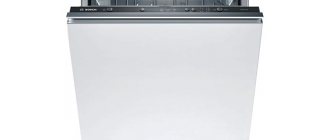Complex installation of a new kitchen unit with a set of equipment is an ideal, but not always possible solution. It happens that a dishwasher is bought later, and there is no special cabinet for its installation. What needs to be done to ensure that the long-awaited acquisition successfully fits into the furniture module?
You will learn everything about how to integrate a dishwasher into a finished kitchen from our article. We will talk about which equipment layout options have been tested in practice. Do-it-yourselfers will find a detailed step-by-step guide here.
Tips for integrating a dishwasher into a finished kitchen
A device for embedding into existing kitchen furniture is chosen especially carefully. To do this, all measurements of the headset are taken into account. Determine in advance the place where the dishwasher will be installed and check whether the door can open freely. The equipment is placed closer to the sewerage system to prevent overload of the system.
To reduce the load on the electrical network, install an additional automatic plug on the panel. It will make using the device safer. If there is a power surge, it will turn off the device and protect it during a possible fire.
Before purchasing the device, determine the approximate length of the hoses. To do this, measure the interval from the connection area to the sewerage and water supply to the future location of the device. The store measures the length of the hoses. If they are short, others buy.
For long and uninterrupted operation, installation is carried out taking into account the following recommendations:
- if a furniture frame is used as a support for the dishwasher, it must be very durable;
- the device is placed away from the hob or electric oven;
- A metal sheet is used to protect the countertop from vapors.
Having completed all steps to connect the dishwasher, the device is checked for functionality. To do this, start the appliance without loading dishes. If everything went smoothly, load the dishes into it.
Tips for connecting hydraulics
All dishwashers have the same hydraulic connection diagram. For example, a 60 cm built-in dishwasher is connected in the same way as a 45 cm wide dishwasher. Here are some tips:
- The standard length of the drain hose is usually sufficient with a large margin. If the machine is located far from the entry point into the sewer, then you will have to additionally install the sewer pipeline closer to the machine.
- To seal connections, use special plumbing sealant.
- To work with a pressure hose you will need certain skills. If you have never done this before, it is better to invite a specialist. This will provide you with quality and reliability.
- If you need to additionally secure the hoses to the wall, then use special anchor clamps. Attach the required number of clamps to the wall and attach the hoses to them. To secure it to the wall you will need a hammer drill.
Read the instructions carefully ↑
Let's preface the story about how to install a dishwasher (DMM) with a banal but important statement: a mandatory document for the installer, which must be studied very carefully before starting work - the installation instructions. The dishwasher must be connected to the water supply, sewerage and power supply, respectively. manufacturer's requirements. Most modern household-level dishwashers are connected using similar circuits, but machines of different types and brands have their own characteristics that must be taken into account both during their installation and during operation.
If preparation for installing a PMM is carried out at the stage of kitchen renovation, when it is not yet known which specific model will be chosen, it is advisable to first determine the type of machine. First of all, with its dimensions and type of water supply. Of course, you can always change something locally, but this is an extra waste of time and money.
Always study the installation and operating instructions for complex household appliances, they contain all the necessary information
How to install a dishwasher: checking the contents and unpacking
Preparing for installation of a dishwasher includes two more stages, in addition to choosing a location: unpacking and checking the contents. It is recommended that unpacking be carried out in the presence of employees of the company from which the unit was purchased. This is necessary in order to check the presence of all parts necessary for installation. If there is a problem with the packaging, then you must inform the company’s employees about it.
Note! You also need to check the availability of instructions (necessarily in Russian). Without it, it is much more difficult to independently understand the design features of a particular model.
If necessary, you can try looking for installation instructions on the company's website. Many well-known brands add them to the product description (for example, Bosch). Dishwasher instructions are very important, so don't ignore this point.
When checking the package, you need to pay attention to the presence of instructions in Russian
In addition to the dishwasher itself, the kit often includes parts that are necessary for the correct installation of decorative trims. It is also necessary to check the presence of retaining elements, a rubber apron used for protection, and gaskets with hoses. The latter are needed when connecting the device.
Possible embedding options
- height 815-875 mm;
- width 598 and 448 mm;
- depth 550 mm.
The range of dimensions allows for the use of several installation options. The control elements of the devices are located at the end of the door, and the legs can be adjusted in height. For a tight fit, the equipment is equipped with corner fasteners and self-tapping screws.
When installing it yourself, it is important to take into account the parameters of the kitchen unit, the presence of water supply and sewerage communications, as well as a free line with an outlet. Advice! Install the machine next to the sink, where there is access to the main water supply and drainage units
Advice! Install the machine next to the sink, where there is access to the main water supply and drainage units.
Cabinet installation
If there are cabinets more than 45 cm wide next to the sink, you can disguise household appliances. Installing a built-in compact dishwasher in a cabinet will allow you to connect the drainage and water intake pipes to ready-made communications. The work includes:
- removal of shelves, bottom panel and back wall from the cabinet;
- vertical adjustment of the PMM body using legs;
- connecting an extended pipe with a shut-off valve for cold water;
- laying a drainage pipe into a siphon;
- organization of an additional outlet;
- installation of a decorative front panel on the device door.
Installation in a free-standing module
- aligning and securing equipment so that it does not move during operation;
- laying hoses and pipes along the walls for ease of access.
Important! The location of the PMM in a separate module eliminates the difficulty of dismantling if the hose breaks
Niche installation
The presence in the kitchen set of a special niche for a microwave, oven or compact equipment solves the question of how best to integrate a household dishwasher into a ready-made, assembled kitchen.
Separating the niche from communication networks involves the use of long flexible hoses for supplying water and drains. The front part of the machine is covered with a cover for the facades.
If embedding is not suitable
- place on the table if the dishwasher is no larger than the oven;
- place in an open module;
- place under the sink;
- allocate a small area for narrow models.
Connection to communications is carried out only after installation of the equipment is completed.
Advice! If there is no room for a built-in device, remodel the kitchen unit, move the lines, but be prepared for large financial costs.
Sources
- https://mebel-expert.info/kak-ustanovit-vstraivaemuju-posudomoechnuju-mashinu/
- https://roomester.ru/interer/kuhnya/ustanovka-posudomoechnoj-mashiny.html
- https://rem.ninja/kuhnya/tehnika/montazh-vstraivaemoy-posudomoechnoy-mashiny-v-gotovuyu-kuhnyu.html
- https://cosmo-frost.ru/posudomoechnye-mashiny/ustanovka-vstraivaemoj-posudomoechnoj-mashiny-chto-delat/
- https://rem.ninja/kuhnya/uhod/kak-vstraivaetsya-posudomoechnaya-mashina-v-kuhnyu.html
- https://kachestvolife.club/o-chistote/bytovaya-tehnika/posudomoechnaya-mashina-kak-samostoyatel-no-vstroit-v-gotovuyu-kuhnyu
- https://tstmoskva.ru/bytovaya-tehnika/kak-ustanovit-posudomoechnuyu-mashinu-poshagovaya-instrukciya.html
- https://vmk-mebel.ru/tehnika/ustanovka-i-podklyuchenie-posudomoechnoy-mashiny/
- https://kuhnier.ru/tehnika/vstraivaemaya/kak-vstroit-posudomoechnuyu-mashinu.html
- https://tehnikoved.ru/kuhnya/posudomoechnaya-mashina/ustanovka-vstraivaemoj-posudomojki.html
Preparation
Communications for connection
The machine requires three external sources to operate:
- electricity - must come from the electrical network of the house to the outlet closest to the car;
- clean cold water - there should be a water pipe nearby with a threaded connection;
- Sewage system - to drain dirty water, there must be sewer pipes nearby with the possibility of connecting an additional drain point.
Choosing a place
When deciding how to install a dishwasher, it is necessary to comply with the main installation condition - ensuring free access to all communications. In this case, the electrical outlet, water pipe (preferably with a faucet for connection) and the sewer drain pipe should be located as close to the machine as possible. In almost every kitchen, this condition is satisfied by a place in the cabinet near the sink.
Conduct the communications necessary for functioning in advance
Kitchen cabinet remodel
There are two options here - a free-standing cabinet or built into a common kitchen countertop. Before installing a dishwasher, let's assume that the dishwasher exactly fits the width and height of the cabinet, so alterations should be minimal.
Example of a cabinet with dishwasher and front panel
It is necessary to dismantle the bottom shelf, the front plinth and then remove the doors. Only the back panel, the tabletop at the top and the side walls of the cabinet remain, which makes this design very unstable.
All dishwashers are designed to be attached to the countertop and side walls, but this varies depending on the manufacturer. If in Electrolux brands the attachment to the side walls occurs at two points (on both sides of the machine in the upper corner under the tabletop), then in Bosch there are four attachment points.
The type of mounting depends on the features of the cabinet for your machine.
The machine is attached to the side walls of the cabinet through four plastic inserts on both sides at the top and bottom of its body, which makes the structure stable and durable.
When purchasing a machine to be built into a separate kitchen cabinet, it is better to give preference to Bosch as a model that provides a more reliable and stable connection.
If the countertop is solid, the cabinet is usually completely dismantled, the dishwasher is placed between the adjacent walls, only the lower decorative panel can remain (often it is used to cover the space between the machine and the floor, cutting it to height).
Excess decorative panel can be used in the kitchen interior
Preparing the water supply and sewerage system for connection
If there is one source of cold water supply in the kitchen, an adapter fitting is installed on the water pipe to ensure water supply to the kitchen sink and dishwasher at the same time. If there was a faucet at the connection point (almost all houses have one installed), you can do without an additional one.
Connecting sewerage and water supply
The sewer pipe from the sink is also replaced with a “tee” with an outlet for connecting the drain hose of the machine (it has a small diameter and an additional rubber sealing ring is additionally purchased and inserted into the outlet, ensuring tightness and a tight fit).
Sometimes the drain hose is connected to a siphon: such a connection is neither aesthetically pleasing nor practical (it takes up useful space under the sink) and leads to additional blockages in the drain system.
Connection through a siphon should be avoided during installation.
Electric outlet
A dishwasher, under certain intensive operating conditions, can consume significant current (about 15 A), which can lead to network overloads if the wiring cross-section is insufficient or when energy-intensive devices are simultaneously connected. Therefore, it is advisable to make the connection to a separate socket with grounding and through its own packet, which automatically switches off in case of overload.
Monitor power modes when washing dishes, as at maximum power the network may overload
How to connect communications
In order to conveniently bring the hoses and wire from the PMM to the place of their connection with the water supply, electricity and sewerage systems, make a large hole or groove for them in one of the side walls of the opening, near the wall (see drawing).
Schematic illustration of one of the options for connecting a dishwasher to cold water, a sewer siphon and an electrical outlet
Tools
To perform work on connecting the PMM, prepare the following tool:
- adjustable wrench;
- Screwdriver Set;
- pliers;
- perforator;
- screwdriver;
- knife.
A set of tools is indispensable in the household
In addition, you will need the following materials:
- tee, preferably with a built-in shut-off valve (thread diameter - 3/4 inch);
- fluoroplastic sealing tape (FUM tape);
- copper 3-core cable with core cross-section 2.5 mm2;
- socket with socket box;
- differential machine;
- fastener
Tee with built-in shut-off ball valve
Additional tools or materials may be required, such as a siphon with an additional outlet for the dishwasher drain hose or a splitter with two outlets instead of a tee. It all depends on the specific location and method of connecting the machine.
Some rules for connecting to communications
The connection point with the water supply and sewerage should be located no further than 1.5 meters from the dishwasher body. Otherwise, problems may arise with water pressure or with drainage of liquid into the sewer.
Correctly executed connection of PMM to communications
A waterproof electrical outlet with a grounding terminal must be capable of withstanding a minimum current of 16 A and must be easily accessible so that the electrical cord plug can be easily connected. The distance from the PMM body to the outlet should not exceed 1 m. Do not connect the dishwasher to the power supply via an extension cord.
The socket should not be placed near a water supply to avoid a short circuit.
You can read in detail about the procedure for connecting a dishwasher to the electrical network, water supply and sewerage in this material.
As you can see, installing the PMM with your own hands is not difficult
All you need is skill in handling the tool, attention and patience.
Required tools and materials
Before you begin installing the dishwasher, you need to prepare tools and consumables.
Dishwasher Installation
Tools
To install the built-in device, you will need the following tools:
- Phillips screwdriver for adjusting the height of the legs, hanging the facade, attaching clamps, etc.;
- laser level to control the horizontal and vertical of the washing cabinet;
- pliers for fixing parts;
- wrenches for connecting the inlet hose, installing a tee and supplying water supply;
- a hammer drill with a crown for concrete and brickwork for installing sockets and hidden wiring;
- screwdriver;
- tape measure, square, marker.
Consumables
Additionally, you will need the following materials if they are not included with the machine:
- fum tape, plumbing tape, gaskets, ties;
- flexible hose with fasteners (cap nuts);
- corrugated hose with a sealing collar and a union nut with a gasket;
- siphon with a pipe for draining water from the dishwasher.
- socket with socket box.
- two-wire wire.
- RCD circuit breaker for the electric meter panel.
Types of dishwashers
Today, stores offer three main types of dishwashers:
- Tabletop;
- Freestanding;
- Built-in.
The main characteristic that can be used to describe desktop models is compactness. Due to their small dimensions, they can be installed directly on the countertop. In this case, the installation of free-standing models will be reduced only to connecting to the power grid and communications. Installation is very simple - they are placed in the form of a separate module or in a niche in the kitchen unit. The most problematic thing for most consumers is the installation and connection of built-in models.
Unlike conventional machines, built-in models do not interfere with the ideas that the designer decided to implement in the interior of the room. In principle, built-in dishwashers are not even visible, since they are hidden under the box - an integral element of the kitchen unit. The front part, which is securely covered with decorative facades, does not remind of their presence. Built-in models are an ideal option for owners of small spaces.
Every housewife knows that before use, the dishwasher must be connected to the mains and filled with water. However, this combination is not safe. The logical conclusion follows from this: during the installation and connection of such equipment, even the slightest inaccuracies are unacceptable.
If you are planning to buy a kitchen set, you can immediately order the installation of a built-in dishwasher. Although not everyone will agree to this option, because it is extra costs. There is another unpleasant moment here - before accepting the work, the owner must already be aware of how this equipment should be installed according to the rules. Otherwise, in a month or two there will be problems with the dishwasher.
What to do if embedding is not suitable
If you can't find room in your kitchen for a built-in dishwasher, then one option is a separate model.
This option does not require any special installation. Just install it on the countertop and connect to the communications. Consider freestanding and tabletop units. Of course there are other alternatives
For example, you can mount the front decorative panel on a free-standing machine. You can also undertake a complete reconstruction of the kitchen unit, highlighting the right space, or move the plumbing communications to another place, but all this requires considerable financial investment, as well as time and effort.
Of course, there are other alternatives. For example, you can mount the front decorative panel on a free-standing machine. You can also undertake a complete reconstruction of the kitchen unit, highlighting the right space, or move the plumbing communications to another place, but all this requires considerable financial investment, as well as time and effort.
You can always allocate space to accommodate your much-needed “kitchen helper”.
How to install a dishwasher in the kitchen
There are two options for installing the PMM: in a finished kitchen or in a pre-designated place in the kitchen unit. Dishwashers vary in type and size:
Compact. Holds from 3 to 5 sets of dishes. Dimensions 50x60x50 cm. Installed on the countertop or under the sink.
Narrow. Width 45 cm, capacity from 6 to 10 sets. Can be fully or partially built-in.
Full size. Dimensions 65x65x90 cm, holds from 10 to 15 sets of dishes. Can be built-in or free-standing.
Typically, manufacturers provide space for placing equipment in any kitchen set. To do this, take the dimensions of a narrow dishwasher and add 5-10 cm to them on all sides. If your kit does not include a special cabinet, then it is better to choose a freestanding machine. You can install it in any convenient place, even between the cabinets.
If you have prepared drawings in advance for placing a Samsung, Miele or other brand dishwasher, there will be no problems with installation. Otherwise, for embedding, select a cabinet close to the sink. Please note that the distance from the PMM body to the rear wall must be at least 5 cm for normal ventilation.
If you have a small family and the kitchen area does not allow you to install a full-size model, choose a tabletop option. You can put it under the sink, and the connection rules do not differ from other models.
Useful tips when choosing and installing PMM
- Before purchasing built-in appliances, measure the dimensions of your kitchen cabinet.
- The legs of the dishwasher can be adjusted in height. Use a level to position the machine level. Some Hotpoint Ariston and Whirlpool models are very sensitive to a tilt of even 2 degrees. This may affect their future work.
- Mount the machine near a sink. This will make it easier to connect the drain and water without having to extend the hoses. Experts say that extending the hoses can lead to leakage and will also put more strain on the drain pump.
When built into furniture, install a metal plate under the tabletop to protect the wood from steam. In built-in models, the plate is included.
What to look for when choosing dishwashing equipment
The advantages of a built-in dishwasher over a free-standing one are that it significantly saves kitchen space and fits harmoniously into the finished design. All you have to do is decide what size machine you need and correlate the dimensions of the equipment with the location of its intended location.
Types of Dishwashers
First of all, all dishwashers can be divided into household and industrial. The latter are used in public catering places and enterprises, so we will not touch on them.
Household dishwashers can be divided into the following types:
- fully built-in - the system is completely hidden behind the furniture facade. The control unit is located at the end of the front wall. Such models are often equipped with an indicator beam. It creates a light marker on the floor surface, which signals that the washing cycle is not completed;
- partially built-in - the front wall is completely open or partially hidden behind the furniture front. The control panel in this case is located above the facade and is accessible even when the machine is turned on;
- free-standing - an independent unit in its own housing; The following classification affects the dimensional characteristics of dishwashers. The machines are distinguished:
- full-size - with a width of 60 cm. An excellent option for a large family. This “helper” can handle a whole mountain of dishes. In one cycle it can wash from 10 to 17 sets. It is easy to place pots and baking trays in it. The height of such machines ranges from 82-87 cm, depth 55-60 cm. They are presented in all categories - built-in, partially built-in, separate;
- narrow - their width can be from 45-49 cm. They can accommodate a maximum of 10 sets of dishes. More suitable for small families of 3-5 people. If the family is large, you will have to run it several times;
- compact - small devices similar in size to a microwave oven. They have a width of 35-45 cm, so they are easy to place in any, even the smallest kitchen. They can wash 4-6 sets of dishes per cycle. Available in built-in and free-standing design options.
Choosing a size
Built-in dishwashers come in several sizes, and, accordingly, can accommodate different amounts of dishes.
Table 1. Dimensions of dishwashers
SizeDimensions in centimetersMaximum capacity (in the number of cookware sets)
| Mini | 50/50/55 | 5 |
| Narrow | 45/55/85 | 8 |
| Full size | 60/60/85 | 17 |
How to plan the installation of installations of various sizes, drawing
Mini dishwashers are convenient because they can be built into a small kitchen, even under a sink or in a pencil case, since it is similar in size to a microwave oven and its location at eye level is quite convenient. Narrow units should only be purchased if you do not have a large family. It is advisable to choose full-size ones if you have a lot of relatives and the house is full of guests. But, you need to understand that such a machine will take up more space in the kitchen.
There are different types of machines, the body dimensions of which may vary.
Energy efficiency classes and labeling
Electricity consumption and energy efficiency are also important points to pay attention to when purchasing. Manufacturers are required to indicate the energy efficiency class for each product. As a rule, it is indicated on a sticker that is pasted onto the device itself or placed in a package with documents for the equipment.
Classes are marked with Latin letters: A+++, A++, A+, A, B, C, D (until 2010, the markings were indicated by the letters A, B, C, D, E, F, G), where, respectively, class A +++ - the most economical model in terms of electricity and water consumption
As a rule, it is indicated on a sticker that is pasted on the device itself or placed in a package with documents for the equipment. Classes are marked with Latin letters: A+++, A++, A+, A, B, C, D (until 2010, the markings were indicated by the letters A, B, C, D, E, F, G), where, respectively, class A +++ – the most economical model in terms of electricity and water consumption.
How energy efficiency classes are marked for various types of dishwashers
But the price for such models will be significantly higher than for a product with a subsequent gradation of classes. The sticker should also indicate:
- product model and brand;
- water consumption in liters per cycle;
- electricity consumption per cycle (kWh);
- drying class (A - G);
- number of sets of dishes;
- class of noise produced in decibels.
Explanation of the symbols found on the sticker that is equipped with the dishwasher body
Types of dishwashers
There are external machines that look like a separate device. They are installed where there is room for them. In appearance, they may resemble a washing machine. Typically, such equipment is small in size, so you can even place it above the countertop.
There are also partially built-in units at points of sale. It’s as if they are recessed into the furniture, but not completely covered. The control panel of the device is usually left. There should be no unnecessary problems with how to build a dishwasher under the countertop, for example.
There are also built-in appliances that are sold without doors. They are equipped with guides to which facades are attached made of the same materials as the buyer’s kitchen sets. On top of such appliances you can install panels that are screwed to the top of the countertops to make the appliance stable.
Useful tips
Here are some useful tips for your attention that will not only allow you to connect your dishwasher correctly, but will also extend the life of the equipment:
- Installing a drain hose into a sink is extremely unsafe, although it makes the connection process much easier. The danger is that the waste water drain may fall out of the sink and flood the neighbors below.
- Electrolux equipment is very demanding in terms of installation rules. The maximum tilt to one side should not exceed 2 degrees, so be sure to check this point with a building level.
- If you decide to buy any model from Siemens, be sure to look at the dimensions of the case and check it with the manufacturing standards of the furniture into which it will be installed. Very often, Siemens neglects technical standards and creates non-standard dimensions, as a result of which difficulties arise when installing a dishwasher in a finished kitchen.
- Do not connect the grounding contact to gas or water pipes under any circumstances. The grounding must be connected to the grounding bus of the apartment panel. We talked about how to make grounding in an apartment in a separate article.
- The air gap between the wall and the back wall of the equipment should be at least 5 cm, which is quite enough for air circulation.
- The kit necessarily contains connection rules and a visual diagram for a specific model. You only need to rely on it, because... All conditions are purely individual, although they have much in common.
- It is not recommended to use surge protectors (extension cords), because they very often cause accidents and fires. If there is no other way to supply power, it is recommended to make an electrical extension cord yourself. This method of connecting a dishwasher via an extension cord can be used as an exception.
- If you decide to place a free-standing dishwasher next to a stove, refrigerator or oven, connect a separate line from the distribution box to each appliance so as not to overload the outlet installed near all devices.
We also recommend watching the visual video instructions for proper use of the dishwasher:
Dishwasher operating tips
https://youtube.com/watch?v=vUIT6ixqu18
That's all the instructions on how to connect a dishwasher to the water supply, electrical network and sewerage system with your own hands. We hope that the information was useful and interesting for you. We also recommend that you familiarize yourself with the main malfunctions of dishwashers, so that in the future you will be familiar with how to repair appliances at home!
Preliminary work before installation of PMM
There are two options for installing a dishwasher: yourself and with the help of specialists. In the first case, you risk connecting the car incorrectly; in the second, you will have to part with part of the family budget.
Sometimes the skills of one craftsman are not enough; you have to call a team of specialists: a furniture assembler, a plumber and an electrician.
Installation services for built-in equipment are offered by companies that sell them. For a certain fee, a universal master comes at the appointed time, carries out all the connection work and checks the serviceability of the machine.
However, if you carefully study the installation instructions, think about connecting hoses, find or install an additional outlet, you can save money and acquire new skills by doing everything yourself.
Choosing a location based on size
An important step is choosing a location for installation. For the built-in model, furniture modules of the first level are suitable, that is, cabinets standing on the floor.
But if you like a compact mini-dishwasher, then its installation is a little easier - such equipment can be inserted at waist or chest level (for ease of maintenance).
There are several conditions for choosing a good location. If they are not followed, you may later encounter problems with water supply/discharge or PMM maintenance.
Image gallery
Photo from
The furniture module adjacent to the washing unit is the most suitable place, since the water supply and drainage units are located nearby, so it is easy to connect the hoses. The length of the hoses should not be long, otherwise the supply and drainage of fluid becomes difficult, which often leads to breakdowns
Prudent owners, even at the stage of interior planning or renovation, think about installing several grounded outlets for powerful household units. If there is no free power point, you will have to draw an additional line
The machine must be placed freely inside the furniture module, with a margin of 5 cm on each side - more precise information is provided in the instructions. The cabinet walls must be strong and able to withstand the fastening elements and the weight of the dishwasher. Rear wall not provided
You should not expect that the machine will be installed once and for all. Sooner or later you will need to replace parts, reconnect hoses or clean some elements. Therefore, the installation is carried out in such a way that possible dismantling is easy and access to communications is open.
Built-in dishwasher next to the sink
Separate grounded socket for dishwasher
Suitable cabinet for dishwasher dimensions
Dishwasher Maintenance
Many installation difficulties arise when a dishwasher is integrated into an already installed kitchen set. You have to adjust cabinets to fit, and sometimes dismantle and remodel some of the furniture.
We recommend that you take care of the installation location before purchasing furniture. This also applies to other household appliances that require integration. Usually, the models you like are first selected, and when drawing up a sketch of the headset, their location and exact dimensions are taken into account. We have provided recommendations for choosing a built-in dishwasher in this material.
Preparation of tools and materials
Manufacturers of built-in PMMs sometimes list in the instructions what tools may be useful during the installation process. However, they expect that preliminary work has already been done.
If measures are required to lay a power line or tap into a pipe, the list of necessary items will increase.
To be on the safe side and save time, you should stock up on the following tools:
- hammer drill or powerful drill;
- adjustable wrench;
- hammer;
- a set of screwdrivers, including flat and Phillips;
- chisel;
- pliers;
- laser level;
- tape measure, square, pencil;
- screwdriver
In addition to tools, you will need connection parts. It is not recommended to use used elements - this will reduce their service life.
To install a socket, you need to buy the electrical installation product itself, a socket box for it, a three-core copper cable, and an additional automatic protective device.
There are special requirements for the socket: it must be of a “European” type, with grounding, preferably protected from moisture, fully operational, without damage
To connect water, you will need a metal tee for inserting into the water supply system, fum tape, a tap for shutting off water, rubber gaskets, clamps or ties for fastenings.
If the siphon is not provided for connecting another drain hose, then it will also have to be changed.
If the voltage in the network often fails, we recommend purchasing a stabilizer. It can be installed on several devices at once.
Instructions for carrying out work
If you have at least some plumbing skills, connecting the PMM to communications will not be difficult.
Below is a general diagram of the connections between the dishwasher and communication systems. Connecting the dishwasher to sewerage, water supply and electricity
How to connect a drain hose to a sewer
You should begin work by installing a siphon with a drain fitting under the sink. If there is also a washing machine installed in the kitchen, you should purchase a siphon with two outlet fittings - these are also on sale.
Siphon with two drain hoses connected to fittings
To prevent liquid from flowing out of the siphon in the opposite direction, and to prevent an unpleasant odor from spreading from the sewer, the drain hose must be secured in such a way that it has an upward bend in front of the siphon. If it is not included in the siphon design or if the hose is connected through a splitter directly into the sewer (after the siphon), it must be directed so that a bend is obtained. To do this, you can use a special insert (see photo below).
Special insert that bends the drain hose
To seal the connection between the hose and the siphon, union nuts are used. If the hose is inserted directly into the sewer, use a special insert or seal the connection in any other way.
In this case, it is not recommended to use sealant, since after this it will no longer be possible to disassemble the structure - you will have to change the entire assembly. Finish the job by connecting the hose to the dishwasher outlet.
Connecting the inlet hose to the water supply
Before performing the second step, carefully read the manufacturer's instructions. The fact is that some PMM models provide connections to both cold and hot water. When washing dishes, the liquid is mixed to the desired temperature, so there is no need to heat it. In this case, you will have to use two tees and connect two hoses to the water supply. But most often you only need to connect cold water.
It is most convenient to install a tee with a shut-off valve at the junction of the pipe and the cold water hose leading to the sink
The inlet and outlet of the tee splitter should be 1/2 inch (20.1 mm outer diameter), the side branch should be 3/4 inch. The shut-off valve must be easily accessible in order to quickly turn off the water in an emergency.
In the case where a washing machine is already connected to the water supply under the sink, use a manifold with two outlets, each of which is equipped with its own ball shut-off valve (see photo).
Water supply manifold with two side outlets
How to connect a dishwasher to the mains
The power of the dishwasher is approximately 2.5–3 kW. Such equipment must be connected to a separate power line coming from the input distribution panel. At the input of the line, you need to place a circuit breaker, which should operate at a current of 16 A, and a residual current device (hereinafter also referred to as an RCD), also at 16 A and 10 mA of leakage current. It is better to choose a copper 3-core cable, with a cross-section of 2.5 mm2, with double insulation.
Connection diagram of the dishwasher to the electrical network
The socket must also withstand a current of 16 A. The cable can be laid by cutting through the walls from the panel to the socket in the kitchen. Or lay the cable in a small box, securing it to the wall surface with self-tapping screws. This wiring option looks good. Grooves will ruin the walls; they are convenient to do only during renovation.
Cable wiring in a box on the surface of the walls
As you can see, there is nothing particularly complicated about connecting a dishwasher to communications. When laying the electrical network, strictly follow safety regulations - turn off the power to the apartment to avoid electric shock.
The ratio of the dimensions of the furniture opening and the dimensions of the dishwasher
To properly install a dishwasher in a kitchen unit, you need to correctly correlate its dimensions with the dimensions of the niche. It’s good if you have already looked at the desired PMM model for yourself, but there is no furniture in the kitchen yet. Then you can independently calculate the dimensions of the future opening for the ideal placement and securing of equipment.
Approximate size ranges for different dishwasher models
The ratio of the sizes of openings and the dimensions of the PMM must meet several important conditions:
- there must be gaps between the machine body and the table top, as well as the side walls of the opening, at least 5 mm on each side;
- from the back wall of the opening to the back panel of the dishwasher body there should be a distance of 80 to 100 mm for convenient placement of the supply hoses and electrical cord.
It is best if there is no back wall in the opening at all - this will avoid kinking the inlet and drain hoses connected to the PMM.
Examples of calculation of openings for different PMMs
The ratio of the size of the machine and the niche for its installation
If you have purchased or just looked at a model of a narrow PMM with a width of 448 mm, a height of 818 mm and a depth of 570 mm, calculating the dimensions of the opening is not a very difficult task. Add 5 mm to the width of the body on both sides and get the opening width - at least 458 mm. If the height of the niche should be 5 mm greater than the height of the body, then the figure will correspond to 823 mm. To the depth of the case - 570 mm - add another 100 mm and get the result - 670 mm (see drawing).
Calculation of opening sizes for a full-size dishwasher
The dimensions of the niche for installing a full-size dishwasher are calculated in a similar way (see drawing).
Hanging the facade on the door of the built-in PMM is not difficult. The instructions for the equipment contain information on how to install the fasteners into which the facade is inserted. Then it is fixed and pulled to the door using fasteners.
We offer our readers a video on how to attach the facade to the door of a Bosch machine:
What should you consider when purchasing?
When choosing a dishwasher, you have to face many difficulties, so it is important to know in advance what to look for when purchasing. If preference is given to a non-built-in model, then the choice may be influenced by both the size and appearance of the equipment
The material for the manufacture of such machines is stainless steel; they do not require a furniture facade, since they have their own and are installed on the floor under the kitchen countertop.
Dimensions
The dimensions of dishwashers have certain standards. They are divided into full-size, narrow and compact. The standard dimensions are 870*600*600 mm (height, width, depth) for full-size machines, and 870*450*600 mm for narrow ones.
This doesn't mean there aren't other options. You can also purchase wider models, for example, 800 mm. Externally, such a dishwasher will be close to a square shape. The capacity of this equipment is very large - up to sixteen sets of dishes.
Narrow dishwashers, in particular non-built-in ones, allow you to load up to nine sets at a time. Compact models take up very little space, and they are designed to be placed on a countertop rather than on the floor.
Their height varies from 450 to 470 mm. The disadvantages of such machines include the visibility of hoses and wires, as well as a small load of dishes. But for one or two people this option is quite acceptable. Even narrow or compact equipment can save significant amounts of water.
The choice of dimensions of a non-built-in dishwasher depends not only on the size of the family, but also on the area of the kitchen. In a small room, no matter how much you want, it is impossible to find a place for large equipment, especially free-standing ones, but the spacious interior will allow you to fantasize with objects as you like.
Unlike full-size appliances, it uses less water, detergent and electricity.
Appearance
The design of a freestanding dishwasher matters a lot. Despite its dimensions, the appliances must meet modern standards, be stylish and fashionable, and highlight the interior of the kitchen.
Manufacturers offer a wide selection of models that differ not only in color, but also in shape, as well as other external parameters.
Class
This designation is used for dishwashers to determine the consumption of electricity, water, and the quality of washing and drying. There are three classes: A, B, C.
The A-class includes elite dishwashing equipment, which economically consumes electricity and water, and ideally copes with washing and drying dishes. B and C are significantly inferior in quality to class A and are being produced less and less often.
Connection to water supply
There are three types of connection methods to the water supply: cold water only, hot water, and both. The first option is preferable for both full-size and narrow dishwashers, because cold water is much cleaner than hot water.
Some people prefer this type, despite the high energy consumption for heating. Connecting to hot water saves electricity, but prevents the equipment from functioning during periods of no hot water supply.
Dish tray
Most manufacturers use stainless steel to make dish trays. This is due to its high strength, resistance to corrosion, durability, and wear resistance.
Plastic containers are also used in manufacturing. They attract with their light weight and reduced price for both built-in and free-standing dishwashers.
The shape and size of the trays also matter. For convenience, containers should accommodate not only plates, but also large utensils such as pots and pans. You also need to make sure that there are small shelves for cutlery so that during the washing process, forks and spoons do not spill all over the machine.
Some trays are quite functional. They fold, disassemble, remove and adjust - it is very convenient to use. Tray designs for narrow and full-size machines differ.
Connection between drain and sewer
This method of independently connecting the dishwasher to the sewer is considered very common. In this case, the connection will be made through a siphon. The method in question requires the technician to act carefully and follow all the advice regarding connecting the dishwasher to the sewer. The drain will need to be equipped with a special outlet and a check valve. This will reduce the likelihood of water flowing directly from the drain into the dishwasher.
The outgoing hose from the machine must be fixed to a wall or cabinet. It is best to place it 50 cm above the drain entrance. To drain water from the dishwasher on its own, tilt the hose at a special angle. The angle is specified in the instructions for your car model. We connect the drain circuit to the siphon under the sink itself. When there is no drain siphon under the sink, then the PMM drain hose must be connected to the sewer pipe outlet, after which the joint should be wrapped as tightly as possible with tape. Under pressure, the hose may fall out; to keep it tightly in the sink, you will need to use a special holder. To connect to the siphon, you need to use an additional fitting. In Moscow stores you can find ready-made options for PMM. Before connecting the drain, you need to re-check the hose size
It is important that there is enough of it; it is better not to use a very long one, because... this has a negative impact on the efficiency of pumping equipment.
Subtleties of installing a dishwasher in a cabinet
If the cabinet was ordered to fit the dimensions of a specific model, then there should be no problems with installation.
The dishwasher body fits freely into the niche, leaving small gaps on both sides. To reduce vibration, seals are glued to the walls.
When installing some dishwashers, for example, Bosch, there is a mandatory part - a metal protective plate fixed to the bottom surface of the countertop. Cars of other brands may not have it.
To take into account all the connection nuances, the machine must be installed in this order:
- First, carry out a fitting - push the unit into a cabinet or niche, check the dimensions and connectivity;
- pull out and carry out preparatory measures - fix the mounting panels, fasteners and vapor protection;
- connect the hoses, push the housing into place;
- install decorative panels.
The difficulty is that models from different manufacturers differ, and therefore some installation points also have discrepancies. To avoid mistakes, you must carefully study the instructions and follow all the recommendations step by step.
A few tips that may come in handy during the dishwasher installation process:
Image gallery
Photo from
Correct insertion of mounting sleeves
Adjusting the dishwasher support legs
Measurements of actual niche parameters
Instructions and recommendations for installing a decorative facade on a car door: first degrease its surface, then glue double tape and a panel onto it. This is necessary to be able to adjust the position of the overlay.
When it becomes clear that the holes on the door and the panel match, you can take a screwdriver and tighten the screws. We recommend that you read the detailed instructions for installing the front on a dishwasher.
Lastly, the side fastening is done. Insert self-tapping screws from the inside of the case into the holes opposite the bushings and also tighten them with a screwdriver. It is prohibited to use nails, otherwise machine parts may be deformed during dismantling.
This is interesting: Set-top box for digital television - information about tuners
Choosing an installation location
In new residential buildings, the project already provides space for household appliances. But if this is a building from previous years, then more often the kitchen furniture was purchased earlier than the PMM, so you have to install a BOSCH dishwasher into a ready-made kitchen set. With this option, some problems may arise, in particular, some cabinets will have to be remodeled, and sometimes completely dismantled.
If the kitchen already has furniture, the best option is to install a Bosch dishwasher under the countertop. Among the models, choose not a free-standing PMM, the dimensions of which are quite large, but a model of a built-in dishwasher. These models have a width of no more than 45 cm. Most of them are equipped with wheeled legs that can be adjusted in height. At the same time, the car easily slides into the niche, which is convenient. Built-in models are equipped with special fasteners, so there are no difficulties with installing them in a niche.
If you are installing a dishwasher in your kitchen unit yourself, then in this case the first-level kitchen modules are most suitable for the built-in model - these are cabinets that stand on the floor. But you can choose a compact mini-model PMM Bosch for your kitchen and install it higher for more convenient use.
A separate issue is installing the front on a dishwasher. This is necessary in the case when the installation of PMM is carried out in a ready-made kitchen set.
Built-in models of BOSCH machines have ready-made templates, which allows you to attach the front to the dishwasher door without any complications. All you have to do is follow the instructions, and then you can easily install the unit.
But first of all, the machine must take its intended place. A handle is attached to the facade, through which the PMM will be opened. Then fastenings are installed to connect the unit to the façade. The screws with nuts for fastening need to be longer, then the connection will be more reliable. The finishing touch can be attaching decorative elements to the door.
How to protect your countertop
When the dishwasher is opened, steam escapes and moisture settles on the underside of the countertop. Regular wetting can lead to swelling and destruction of the surface. In this case, not only the tabletop will suffer, but also the facade. To protect furniture from moisture, special waterproof plates should be used. Manufacturers offer various protection options - elements made of metal, plastic or film. Bosch dishwashers come with metal linings. Electrolux offers protection from a special film. If a plate is not included in the set, this does not mean that it is not needed. In this case, you will have to find an alternative yourself - you can stick tape, attach a piece of metal, or purchase a ready-made element separately.
An indispensable assistant in the kitchen
Regardless of the functional equipment, the dishwasher will be able to benefit the housewife in her everyday affairs. It saves time as well as water consumption. This is especially true in modern conditions, when one can only be amazed at how quickly utility tariffs are rising. This useful household appliance will be able to return the money spent on it in literally 2-3 years of active use.
Lately, many consumers don’t even think much about whether they need a dishwasher in their kitchen. Many people can no longer imagine their life without this useful unit, so after purchasing a stove and refrigerator they begin to think about this device. But in order for this equipment to work within the period that the manufacturer set for it, it is necessary to install it correctly.
Many owners install a dishwasher in their kitchen unit with their own hands, thereby hoping to save not only time, but also money. But this does not always go without complications, because not everyone is familiar with the nuances of this process. Even the fact that each model comes with installation instructions doesn't help them much. To do this, you need to have certain skills and knowledge that the average consumer simply does not have.
Recommendations for use
For proper and careful operation of the dishwasher, it is important to follow certain rules:
When loading dishes, be sure to remove large food particles. It is recommended to rinse particularly greasy dishes, such as frying pans, with hot tap water before loading. This will make the machine easier to operate and save a lot of energy. Large items - pots, pans - are loaded into the lower baskets.
It is recommended to set the washing mode to gentle. In fact, it is a self-regulating regime. If you load homogeneous objects, for example, porcelain cups, set the appropriate mode with a lower or, conversely, high heating temperature. For each machine, such modes are described in detail in the attached instructions.
As for the products, their range on the consumables market is represented by the following classes:
The last class deserves special attention. Hard water is not suitable for a dishwasher. This is why salts exist - they soften the water, which affects the quality of the wash and the efficiency of the machine.
During installation of the dishwasher, its repair and maintenance, the power supply must be interrupted. For this purpose, a separate power module with automatic switches is installed. If such a unit is missing, you will have to turn off the power to the entire kitchen line or even the entire apartment.
Preparing communications
It's no secret that a built-in dishwasher needs a stable connection to the electrical network, a connection to the water supply (sometimes to both hot and cold water at once) and sewerage. It is better to prepare these communications at the very beginning of kitchen renovation. Let's start with electrics.
- Using a hammer drill and a chisel, we tap the wall for the electrical wiring.
- In the electrical panel we draw a three-wire wire and install the automatic switch.
- We connect a pre-prepared copper wire to the difavtomat and pull it into the kitchen, through a grooved channel to the location of the socket box.
- We hollow out a niche for the socket box, install it and remove the wire.
- We disassemble the moisture-resistant socket, connect it to the wires and screw it in place.
At first glance, nothing complicated, but in practice problems may arise, so if you do not have experience in handling electricity, contact a specialist. The connection to electricity has taken place, now it’s time to install the wiring for the water pipes. First, figure out how you will connect your dishwasher to hot and cold water or just cold. Most often, craftsmen connect “dishwashers” only to cold water - this is best.
- At the end of the outlet of the cold water pipe, install a tee (or a tee with a tap).
- We get two free leads, one will go to the sink faucet, and to the other we will connect the dishwasher inlet hose.
- All threaded connections must be taped with a foam tool to ensure the connection is as reliable as possible.
We will connect the dishwasher to the sewer system last after the sink and siphon have been installed. All we have to do is connect the drain hose to the siphon outlet, and we can complete connecting the dishwasher in a few minutes.
Temporary connection for dishwasher
Now let's figure out how to install a built-in dishwasher separately from the furniture set.
First you need to connect the drain hose to the sewer. To do this, you can connect it to part of the sink drain, which, in turn, connects to the sewer pipe
In this case, it is important to create a bend near the “joining” point so that waste waste does not linger in the hose. As a last resort, you can simply leave the drain hose in the sink. Make sure that the length of the drain hose is no more than 1.5
In extreme cases, you can leave 2m. Now you need to deal with the inlet hose. In order to install it, you must first install a special hose tee. Remove the faucet hose from the water supply and replace it with a brass or bronze adapter. Now install the mixer on one branch, the filter on the second, and the dishwasher hose on the third.
Now you know how to operate your dishwasher without having to build it in until the kitchen furniture arrives. Try out new equipment and get out of the habit of washing dishes by hand.
Share your opinion - leave a comment
Features of installation of PMM depending on its type
The installation of this equipment depends on the type of dishwasher. In turn, the type of such a device is often selected based on the features and placement of kitchen furniture, as well as the size of the kitchen. Thus, installing a dishwasher in a finished kitchen can cause difficulties if the room is small and already densely packed with furniture and equipment. The built-in machine can only be installed in the niche intended for it. Installing a tabletop dishwasher in this sense is easier, but there are also not so many places suitable for this equipment. The best option is to think through the kitchen interior and the place of household appliances in it in advance. However, this option is not always possible.
If there is very little space for placing equipment, compact small-sized models are installed, the width of which is approximately 60 cm. Such a device can simply be installed in a cabinet above the sink or on a table. The disadvantage of compact models is their small capacity - usually they can be loaded with up to five units of various utensils, but in a small kitchen they are indispensable.
The so-called narrow models are more spacious. They are narrower than full-size devices, but larger than compact ones, and their functionality usually does not differ from the functionality of full-size devices. There are free-standing devices, and there are also built-in ones. For free-standing appliances, as a rule, there are several placement options, and if necessary, they can be moved around the kitchen. Built-in models can only be installed in a certain niche in the kitchen set.
Finally, full-size models can also be free-standing or built into a set. The installation of such equipment is no fundamentally different from the installation of narrow PMMs, but devices of this type may simply not fit into a cramped kitchen.
What to do if embedding is not practical
Some kitchen sets do not provide the possibility of installing a dishwasher. In addition, there may simply not be free space in the furniture. What to do in this case? In such a situation, it is best to purchase a freestanding model.
Dishwashing units of this type do not require complex integration work, so this option is perfect for people who do not want to spend a lot of time fiddling with the installation. There are three placement methods for freestanding devices:
- on the floor;
- into a niche;
- on the tabletop.
The best models, installed separately, are also produced by Electrolux. Installing a dishwasher of this type will not cause any particular difficulties. In this case, all work is reduced, as a rule, only to connecting to the power grid and other communications.
If it is not possible to install a dishwasher in your kitchen unit, you can purchase a separate model
You can completely remake some of the modules that are part of the kitchen ensemble. Transferring communications is also possible, but this is quite labor-intensive work. Usually this option is chosen last, when it is necessary to integrate a free-standing model and install a decorative facade on its front side.











